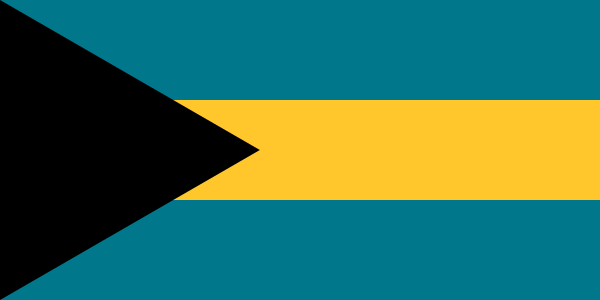National flag
 The colours embodied in the design of the Bahamian flag symbolise the image and aspirations of the people of The Bahamas; the design reflects aspects of the natural environment (sun, sand, and sea) and the economic and social development. The flag is a black equilateral triangle against the mast, superimposed on a horizontal background made up of two colours on three equal stripes of aquamarine, gold and aquamarine.
The colours embodied in the design of the Bahamian flag symbolise the image and aspirations of the people of The Bahamas; the design reflects aspects of the natural environment (sun, sand, and sea) and the economic and social development. The flag is a black equilateral triangle against the mast, superimposed on a horizontal background made up of two colours on three equal stripes of aquamarine, gold and aquamarine.The symbolism of the flag is as follows: Black, a strong colour, represents the vigour and force of a united people, the triangle pointing towards the body of the flag represents the enterprise and determination of the Bahamian people to develop and possess the rich resources of sun and sea symbolized by gold and aquamarine respectively. In reference to the representation of the people with the colour black, some white Bahamians have joked that they are represented in the thread which "holds it all together."
Coat of arms
 The Coat of Arms of The Bahamas contains a shield with the national symbols as its focal point. The shield is supported by a marlin and a flamingo, which are the national animals of The Bahamas. The flamingo is located on the land, and the marlin on the sea, indicating the geography of the islands.
The Coat of Arms of The Bahamas contains a shield with the national symbols as its focal point. The shield is supported by a marlin and a flamingo, which are the national animals of The Bahamas. The flamingo is located on the land, and the marlin on the sea, indicating the geography of the islands.On top of the shield is a conch shell, which represents the varied marine life of the island chain. The conch shell rests on a helmet. Below this is the actual shield, the main symbol of which is a ship representing the Santa María of Christopher Columbus, shown sailing beneath the sun. Along the bottom, below the shield appears a banner upon which is scripted the national motto.
National flower
 The yellow elder was chosen as the national flower of The Bahamas because it is native to the Bahama Islands, and it blooms throughout the year.
The yellow elder was chosen as the national flower of The Bahamas because it is native to the Bahama Islands, and it blooms throughout the year.Selection of the yellow elder over many other flowers was made through the combined popular vote of members of all four of New Providence's garden clubs of the 1970s – the Nassau Garden Club, the Carver Garden Club, the International Garden Club, and the YWCA Garden Club.
They reasoned that other flowers grown there – such as the bougainvillea, hibiscus, and poinciana – had already been chosen as the national flowers of other countries. The yellow elder, on the other hand, was unclaimed by other countries (although it is now also the national flower of the United States Virgin Islands).
